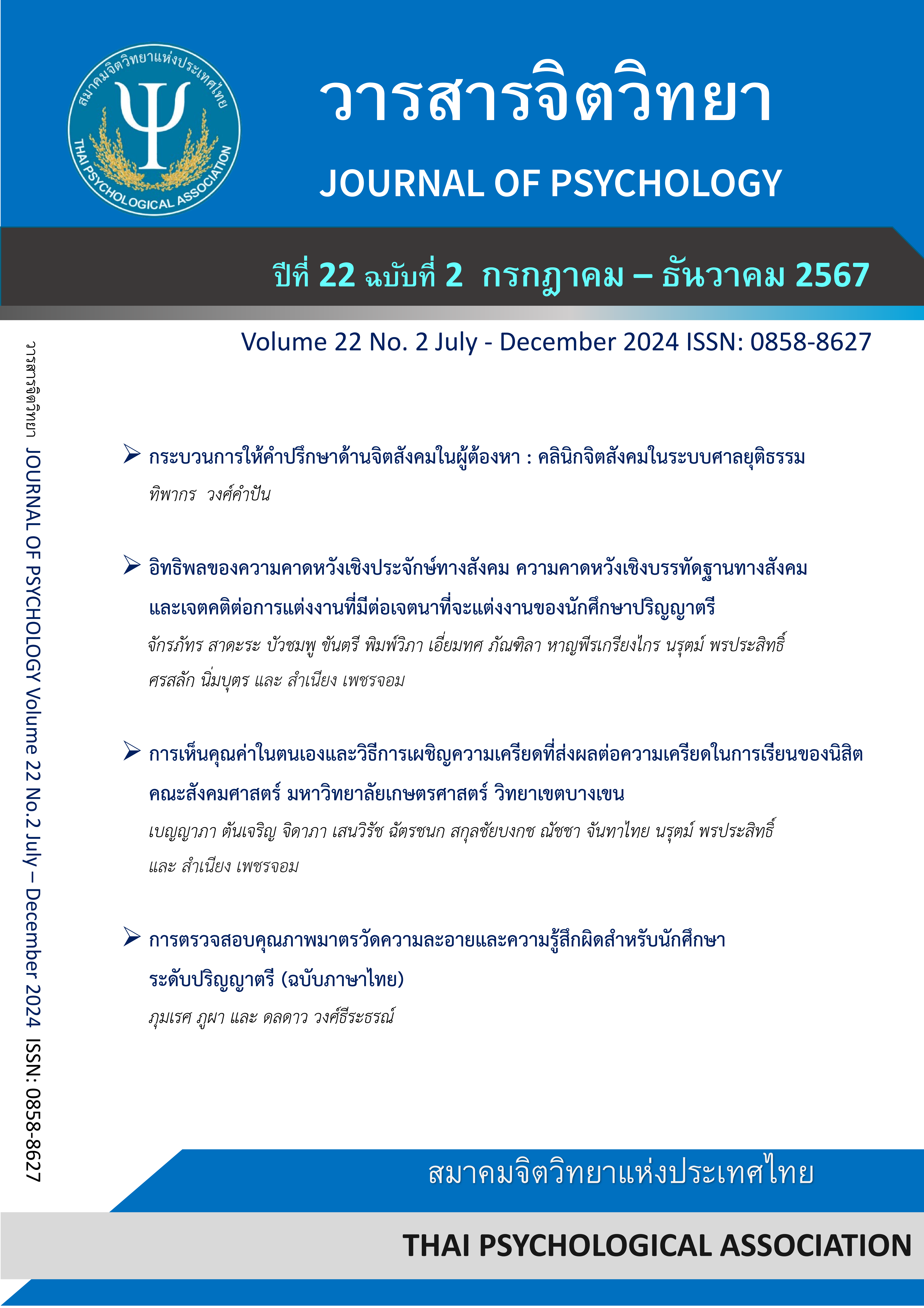Effects of Normative Expectation, Empirical Expectation, and Attitudes Toward Marriage on Intention to Marry Among Undergraduate Students
Keywords:
Empirical expectations, Normative expectations , Attitudes toward Marriage Intention to marriageAbstract
Abstract
Marriage is a significant life event that draws attention in social and cultural contexts worldwide. In this study, we aimed to explore how normative expectations, empirical expectations, and marriage attitudes affect undergraduate students’ intention to marry. The study involved 216 undergraduate students as participants by accidental sampling. Data was collected using a questionnaire divided into five sections: a personal factors questionnaire, an attitude toward marriage questionnaire, an empirical expectations questionnaire, a normative expectations questionnaire, and an intention to marriage questionnaire. Cronbach’s alpha coefficients for the questionnaires ranged from 0.81 to 0.88. Percentage, mean, standard deviation, Pearson’s correlation coefficient, and Multiple regression were used for analysis. The results indicated that attitudes toward marriage (β = 0.872 , p < .001) significantly predicted the intention to marriage of undergraduate students while empirical expectations and normative expectations did not demonstrate statistical significance in predicting. The results of this study can be used as a foundational basis for the development of policies or strategies aimed at promoting understanding of marriage among students, with a focus on fostering positive attitudes toward marriage.
References
เอกสารอ้างอิง
สำนักงานปลัดกระทรวงการอุดมศึกษา วิทยาศาสตร์ วิจัยและนวัตกรรม. (2567). สรุป รายงานจำนวน
นักศึกษา ปีการศึกษา 2567 ภาคการศึกษาที่ 1.
https://info.mhesi.go.th/stat_std_all.php?search_year=2567
บุญใจ ศรีสถิตย์นรากูร. (2563). ขนาดอิทธิพล การวิเคราะห์อำนาจ การคำนวณขนาดตัวอย่างที่เหมาะสมโดย
โปรแกรม G*Power. สำนักพิมพ์จุฬาลงกรณ์มหาวิทยาลัย.
อมินดารา อริยธาดา. (2564). รูปแบบความสัมพันธ์เชิงสาเหตุด้านคุณลักษณะทางจิตและสภาพแวดล้อม
ทางการศึกษา ที่ส่งผลต่อพฤติกรรมการมุ่งเน้นการเป็นผู้ประกอบการ โดยส่งผ่านความตั้งใจที่จะเป็นผู้ประกอบการของนักศึกษา สาขาผู้ประกอบการ (ปริญญา
นิพนธ์วิทยาศาสตร์มหาบัณฑิต, มหาวิทยาลัยศรีนครินทรวิโรฒ).
Abdurahman, D., Assefa, N., & Berhane, Y. (2023). Adolescent Girl’s Early Intention to
marriage and its Determinants in Eastern Ethiopia: A Social Norms Perspective. Sage Open, 13(2), 1-11.
https://doi.org/10.1177/21582440231182352
Ajzen, I. (1991). The theory of planned behavior. Organizational Behavior and Human
Decision Processes, 50(2), 179–211. https://doi.org/10.1016/0749-5978(91)90020-T
Fishbein, M., & Ajzen, I. (1975). Belief, Attitude, Intention, and Behavior: An Introduction to Theory and Research. Reading, MA: Addison-WesleyAjzen, I. (2020). The theory of planned behavior: Frequently
asked questions. Human Behavior and Emerging Technolo-gies,2(4), 314–324
Ajzen, I. (2020). The theory of planned behavior: Frequently asked questions. Human Behavior and Emerging Technolo-gies,2(4), 314–
https://doi.org/10.1002/hbe2.195
GBD 2021 Fertility and Forecasting Collaborators. (2024). Global fertility in 204
countries and territories, 1950–2021, with forecasts to 2100: A comprehensive demographic analysis for the Global Burden of
Disease Study 2021. The Lancet (London, England), 403(10440), 2057–2099. https://doi.org/10.1016/S0140-6736(24)00550-6
Bicchieri, C. (2006) The grammar of society: The nature and dynamics of social norms.
CamBibridge University Press, New York.
Bicchieri, C., & Mercier, H. (2014). Norms and beliefs: How change occurs. In M. Xenitidou & B.
Edmonds (Eds.), The complexity of social norms (pp. 37–54). https://doi.org/10.1007/978-3-319-05308-0_3
Fishbein, M., & Ajzen, I. (1975). Belief, Attitude, Intention, and Behavior: An Introduction to
Theory and Research. Reading, MA: Addison-Wesley
Fukuda, S. (2020). Marriage will (continue to) be the key to the future of fertility in Japan and
East Asia. Vienna Yearbook of Population Research, 18, 71–80. DOI: 10.1553/populationyearbook2020.deb07
Jaisuekun, K., & Sunanta, S. (2023). Til death do us part? End-of-life care for ageing Western
husbands in Thailand. Gender, Place & Culture, 31(12), 1667-1689.
https://doi.org/10.1080/0966369X.2023.2229059
Lee, M. (2022). The Consequences of Declining Fertility for Social Capital: Joint Economic
Committee Report. Joint Economic Committee Replubicans. https://www.jec.senate.gov/public/_cache/files/635c69dc-6a5a-467b-
b7b0-3ab906fb4a94/the-consequences-of-declining-fertility-for-social-capital.pdf
Mackie, G., Moneti, F., Denny, E., & Shakya, H. (2015). What are social norms? How are they
measured? San Diego, CA: UNICEF and University of California, San Diego, Center on Global Justice.
Nejatian, M., Alami, A., Tehrani, H., Jahantigh, H., & Jafari, A. (2021). Attitude, Intent and
Different Aspects of Marriage in University Students: A Path Analysis. Journal of Divorce & Remarriage, 63(3), 184–199.
https://doi.org/10.1080/10502556.2021.1993024
Panpothong, N., & Phakdeephasook, S. (2023). Independence or Interdependence?: The Thai
Self-Construal as Reflected by Linguistic Evidence. Manusya: Journal of Humanities, 26(1), 1-25. https://doi.org/10.1163/26659077-
Pummanee, T., Tedla, Y. G., & Riesch, S. K. (2018). Barriers to the quality of parent-adolescent
communication in Thailand: An ecological system analysis. International Journal of Child Development and Mental Health, 6(1), 87-
Retrieved from https://he01.tci-thaijo.org/index.php/cdmh/article/view/122867
Rattanawijan, S. ., & Srimuang, D. (2022). “Why Do Not You Get Married?”: World View of
Woman and Marriage in Thai Society. Academic and Research Journal of Liberal Arts (Online), 17(2), 190–204.
https://doi.org/10.14456/lar.2022.21
Raymo, J. M., Uchikoshi, F., & Yoda, S. (2021). Marriage intentions, desires, and pathways to
later and less marriage in Japan. Demographic research, 44, 67–98. https://doi.org/10.4054/demres.2021.44.3
Retherford, R. D., Ogawa, N., & Matsukura, R. (2001). Late Marriage and Less Marriage in
Japan. Population and Development Review, 27(1), 65–102. https://doi.org/10.1111/j.1728-4457.2001.00065.x
Shahrabadi, R., KarimShai-Shahanjarini, A., Dashti, S., Soltanian, A., & Garmaroudi, G. (2017).
Predictors of intention to marriage based on theory of planned behavior among university students in Iran. Electronic physician,
(4), 4090–4095. https://doi.org/10.19082/4090
Tamizarasi, K., & Jecinth, J. R. B. (2023). Relationship between general attitude towards
marriage and aspects of marriage in young adults. The International Journal of Indian Psychology, 11(3), 276–283.
https://doi.org/10.25215/1103.276
United Nations Population Fund (UNFPA). (2015). The state of Thailand’s population 2015:
Features of Thai families in the era of low fertility and longevity. Retrieved from https://thailand.unfpa.org
Xie, J., & Hong, X. (2022). Research on Factors Affecting Chinese College Students' marriage
intention: Applying the Theory of Planned Behaviour. Frontiers in psychology, 13, 868275.
Published
How to Cite
Issue
Section
License
Copyright (c) 2025 Thai Psychological Association

This work is licensed under a Creative Commons Attribution-NonCommercial-NoDerivatives 4.0 International License.
บทความที่ได้รับการตีพิมพ์เป็นลิขสิทธิ์ของสมาคมจิตวิทยาแห่งประเทศไทย
ข้อความที่ปรากฎในบทความแต่ละเรื่องในวารสารวิชาการเล่มนี้เป็นความคิดเห็นส่วนตัวของผู้เขียนแต่ละท่านไม่เกี่ยวข้องกับสมาคมจิตวิทยาแห่งประเทศไทย แต่อย่างใด ความรับผิดชอบองค์ประกอบทั้งหมดของบทความแต่ละเรื่องเป็นของผู้เขียนแต่ละท่าน หากมีความผิดพลาดใด ๆ ผู้เขียนแต่ละท่านจะรับผิดชอบบทความของตนเองแต่ผู้เดียว






